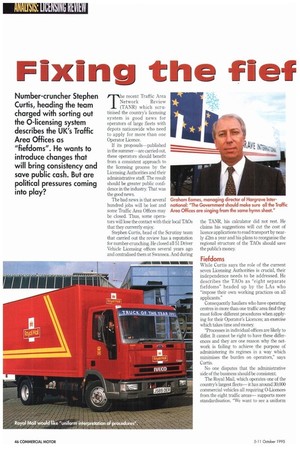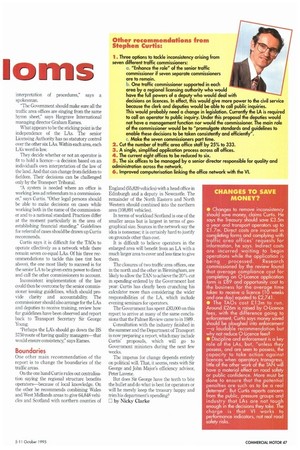Fixing the fief
Page 48

Page 49

If you've noticed an error in this article please click here to report it so we can fix it.
Number-cruncher Stephen Curtis, heading the team charged with sorting out the 0-licensing system describes the UK's Traffic Area Offices as "fiefdoms". He wants to introduce changes that will bring consistency and save public cash. But are political pressures coming into play?
Tlie recent Traffic Area
Network Review (TANR) which scrutinised the country's licensing system is good news for operators of large fleets with depots nationwide who need to apply for more than one Operator Licence.
If its proposals—published in the summer are carried out, these operators should benefit from a consistent approach to the licensing process by the Licensing Authorities and their administrative staff. The result should be greater public confidence in the industry That was the good news.
The bad news is that several hundred jobs will be lost and some Traffic Area Offices may be closed. Thus, some operators will lose the contact with their local TAOs that they currently enjoy.
Stephen Curtis, head of the Scrutiny team that carried out the review has a reputation for number-crunching. He closed all 51 Driver Vehicle Licensing offices several years ago and centralised them at Swansea. And during the TANK his calculator did not rest. He claims his suggestions will cut the cost of licence applications to road transport by nearly 42m a year and his plans to reorganise the regional structure of the TAOs should save the public's money.
Fiefdoms
While Curtis says the role of the current seven Licensing Authorities is crucial, their independence needs to be addressed. He desCribes the TAOs as "eight separate fiefdoms" headed up by the LAs who "impose their own working practices on all applicants."
Consequently hauliers who have operating centres in more than one traffic area find they must follow different procedures when applying for their Operator's Licences; an exercise which takes time and money.
"Processes in individual offices are likely to differ. It cannot be right to have these differences and they are one reason why the network is failing to achieve the purpose of administering its regimes in a way which minimises the burden on operators," says Curtis.
No one disputes that the administrative side of the business should be consistent.
The Royal Mail, which operates one of the country's largest fleets— it has around 30,000 commercial vehicles all requiring 0-Licences from the eight traffic areas— supports more standardisation. "We want to see a uniform interpretation of procedures," says a spokesman.
"The Government should make sure all the traffic area offices are singing from the same hymn sheet," says Hargrave International managing director Graham Eames.
What appears to be the sticking point is the independence of the LAs. The senior Licensing Authority has no statutory control over the other six LAs. Within each area, each LAs word is law.
They decide whether or not an operator is fit to hold a licence—a decision based on an individual's own interpretation of the law of the land. And that can change from fiefdom to fiefdom. Their decisions can be challenged only by the Transport Tribunal.
"A system is needed where an office is working less ad referendum to a commissioner," says Curtis, "Other legal persons should be able to make decisions on cases while working both in the name of the commissioner and to a national standard Practices differ at the moment particularly in the area of establishing financial standing" Guidelines for referral of cases should be drawn up Curtis recommends.
Curtis says it is difficult for the TAOs to operate effectively as a network while there remain seven co-equal LAs. Of his three recommendations to tackle this (see tint box above), the one most likely to succeed is for the senior LA to be given extra power to direct and call the other commissioners to account.
Inconsistent implementation of the law could then be overcome by the senior commissioner issuing guidelines, which should provide clarity and accountability. The commissioner should also arrange for the LAs and deputies to receive training, review how far guidelines have been observed and report back to Transport Secretary Sir George Young.
"Perhaps the LA's should go down the BS 5750 route of having quality managers—that would ensure consistency," says Eames.
Boundaries
One other main recommendation of the report is to change the boundaries of the traffic areas.
On the one hand Curtis rules out centralisation saying the regional structure benefits operators—because of local knowledge, On the other he recommends combining Wales and West Midlands areas to give 64,848 vehicles and Scotland with northern counties of England (55,820 vehicles) with a head office in Edinburgh and a deputy in Newcastle. The remainder of the North Eastern and North Western should combined into the northern area (108,891 vehicles).
In terms of workload Scotland is one of the smaller areas but is largest in terms of geo. graphical size. Sources in the network say the idea is nonsense; it is certainly hard to justify on grounds other than cost.
It is difficult to believe operators in the enlarged area will benefit from an LA with a much larger area to cover and less time to give them.
The closures of two traffic area offices, one in the north and the other in Birmingham, are likely to allow the TAN to achieve the 20% cut in spending ordered by the Government last year: Curtis has clearly been crunching his calculator more than considering the wider responsibilities of the LA, which include evening seminars for operators.
The Government has spent 183,000 on this report to arrive at many of the same conclusions that the Palmer Review came to in 1989.
Consultation with the industry finished in the summer and the Department of Transport is now preparing a report, which may include Curtis' proposals, which will go to Government ministers during the next few weeks.
The impetus for change depends entirely on political will. That, it seems, rests with Sir George and John Major's efficiency advisor, Peter Lavene.
But does Sir George have the teeth to bite the bullet and do what is best for operators or will he merely keep the treasury happy and trim his department's spending?
0 by Nieky Clarke




































































































































